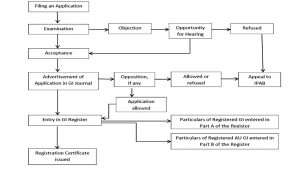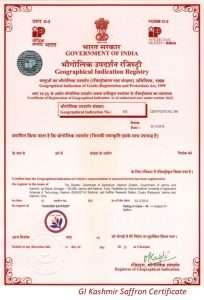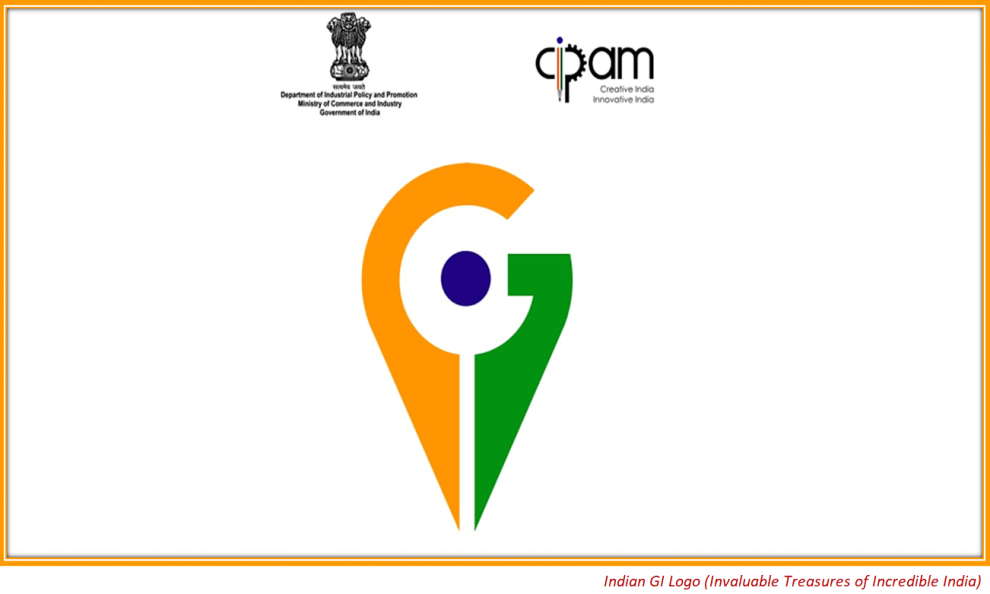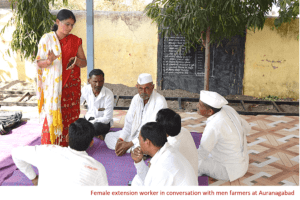In this blog, D Alagu Niranjan and Sujeet Kumar Jha elaborate on the importance of Geographical Indications (GI) in protecting producers’ rights and saving consumers from deception, and what extension professionals could do to promote GI in their work with communities and manufacturers of value-added products.
CONTEXT
Geographical Indications (GI) is a relatively new concept to India as there was no such thing before 1999, when Government of India passed an Act in parliament named, ‘Geographical Indications of Goods (Registration and Protection) Act, 1999’. The Act was operational after almost three years (15 September 2003) since its passing in parliament. Now, the GI Registry is working under the Ministry of Commerce and Industry and its office is located in Chennai (Tamil Nadu). The purpose of the registry is to register the agricultural, food, manufactured, natural and handicraft products which is original and unique to a specific geographical location where it is produced. Since its inception, the GI Registry is working tirelessly to register various products under the above mentioned categories. Around 370 products have been registered so far; it includes agricultural items and foodstuffs. The list of the registered products until March 2019 could be accessed from https://ipindia.gov.in/writereaddata/Portal/Images/pdf/GI_Application_Register_new.pdf
HOW ARE REGISTRATIONS MADE?
The registration of GI is a legal process which can be done by any association of persons, producers, organization or authority established by or under the law who represent the interest of the producers by making an application to the GI Registry with the prescribed application fee. The registered applicant is considered as the registered proprietor of the product. The registered proprietor is responsible by law to maintain the standards of the production of products and to recommend it to the GI Registry for approving authorized user registration. The registered proprietor will constitute a committee to check the standards maintained by the producers of the region. Here further doubt arises as to who is an authorized user. Officially an authorized user is defined as one who got official inclusion of his/her product which is confined to the territory of the previously registered GI product. In other words, s/he is a person who is residing in the geographical territory and producing the same good but is not associated with the proprietor association or organization. As stated earlier, the proprietor organization is involved in the process of authorized user registration along with the GI Registry.
 *IPAB- Intellectual Property Appellate Board; AU- Authorized Users
*IPAB- Intellectual Property Appellate Board; AU- Authorized Users
Figure 1. Flowchart of GI Registration in India (adopted from GI Journal)
Source: https://ipindia.gov.in/the-registration-process-gi.htm
SO, WHAT IS THE PROBLEM?
As an Intellectual Property Right (IPR), GI is associated with different benefits which are not fully exploited in India – that is the problem.
Benefits of GI registration
The main benefits from GI registration is protecting producers’ rights and saving consumers from deception.
Some of the direct benefits are as follows:
- Proprietorship of the geographical region as a community right; that is, the right to produce the product stays with the producers of that geographical territory forever;
- Exclusive right to use GI logo and product’s registered logo;
- Protection against commercial exploitation by the people from other regions. When any exploitation occurs, the exploiters can be prosecuted under GI law;
- Using authorized user number in the package, the product can be traced from anywhere in the world.
Other associated benefits are:
- Market benefits include high value creation (Normal orange vs. Nagpur orange; which one would you prefer?) and reduced advertisement cost;
- Consumer satisfaction;
- Overall development of the region.
 GI tagged Basmati Rice, Darjeeling Tea, Nagpur Orange and Mizo Chilli
GI tagged Basmati Rice, Darjeeling Tea, Nagpur Orange and Mizo Chilli
WHY DO THESE PROBLEMS EXIST?
- Unfamiliarity with the GI concept: Since the concept is an unfamiliar one, we are unable to exploit the benefits. Perception that famous products do not get any additional advantage of GI registration. Hence, not enough efforts are taken to exploit these benefits.
- Lack of awareness: Producers not aware of commercial benefits and consumers not aware of the originality of products (e.g., People visiting Bengal may assume Bengal Rasagolla as original instead of Banglar Rasogolla).
- Absence of intervention: The duty of popularization is binding on the proprietor organization or association. But, in most cases, the proprietor organization or association remains silent (as it assumes registration itself is a big deal). This causes less authorized user registration and entry of more fake products in the geographical territory.
- Absence of responsibility: The GI Act does not place any responsibility on either GI Registry or any other government office. Therefore, GI functions at the local level as follows:
a. The proprietor files an application with or without the knowledge of the producer community of a specific product;
b. The GI Registry registers;
c. The end.
Only a few products have successfully executed the post-registration aspects of GI with the help of responsible proprietors.
5. No one is legally obligated to revive a dormant GI when the proprietor loses interest (resulting in bystander effect).
6.No enforcement till there is a complaint filed, because it is law.
These have resulted in the following:
- Seen yet unnoticed: Most people are aware that there is an Intellectual Property (IP) called GI but very few know the details. We get deceived as we lack details. For example, we may be well aware in differentiating McDonald’s from McDoland’s but we are not fully aware in identifying real Banglar Rasogolla from Bengal Rasagolla.
- The stakeholders in some of the registered GI cases (e.g., Darjeeling Tea, Alphonso Mango, etc.) are well aware of the post-registration challenges; whereas there are many registered products that do not even have a brand image and reputation in other parts of the country (Das 2010).
- The only metric evidence available to know the performance of GI is by assuming number of authorized users under each product (i.e., more authorized users equals to more benefits to producers and consumers). The foundation of this assumption is: greater the number of authorized users greater the probability of consumers receiving original products, as the geographical territory contains more shops of the original product. For example, the probability of eating original Solapur Pomegranate in Solapur is higher than the probability of eating original Srivilliputtur Palkova in Srivilliputtur, because the Solapur Pomegranate has 646 authorized users, whereas Srivilliputtur Palkova contains zero authorized users. Around 100 of the 125 registered agricultural and food products have one or no authorized users.
- These claims cannot be proven with scientific evidence because there is very little research on this concept. That is the reason why the blog is titled, ‘Why aren’t we talking about Geographical Indications?’
WHAT NEEDS TO BE DONE?
Discussions on academic and administrative platforms
Holding discussions on GI-related topics will help to create awareness about the topic and help in realizing its importance. The following topics can be at the top in the list for discussions:
- Utility and role of GI and other IPRs like PPV&FRA and Trademarks in Agriculture;
- Farmer’s/producer’s rights and its influence on his/her day to day life;
- Role of GI in sustainable development;
- Improving awareness of the producers and the consumers;
- Building a brand image for each and every registered product and their commercialization;
- Improving authorized user registration;
- Self-reliance (Aatmanirbhar) and taking local treasures to the whole world;
- Methods to measure the impact of GI on sustainable development of the region;
- Comparing GI registered traditional products with other non-registered traditional products;
- Role of commodity boards in achieving GI’s goal.
For example, let’s take ‘Improving awareness of the producers and the consumers’ for a discussion. The academic discussion of this topic would result in development of GI awareness kits, development of scales for measuring awareness of producers and consumers, identification of factors that influence producer and consumer awareness, and finally, we may fit the identified factors to a theory or will develop a new theory. The administrative discussion of this topic could result in conducting awareness programmes in a newly registered GI product territory, conducting an exhibition to differentiate original products from fake products and organizing a training programme for local youth so as to impart technical knowhow of the GI registered product in order to promote entrepreneurship in the region.
Academic discussions can take place when the university IPR cell, social sciences departments and legal experts work together and administrative discussions can take place when state departments, NGOs and other field level extension professionals work together. But, a policy is the product of both academic and administrative discussions. Hence, for a better GI policy, people from both extension science and extension service should work together.
Organising trainings for extension professionals
 The Government of India has established Rajiv Gandhi National Institute of Intellectual Property Management (RGNIIPM) in Nagpur, which functions under the Ministry of Commerce and Industry; and its primary function is to conduct training programmes for the public on IPR. If ICAR or Ministry of Agriculture and Farmers Welfare takes up an initiative to address the problem at the national level, we can request the RGNIIPM, Nagpur, and GI Registry, Chennai (World Intellectual Property Organization, Geneva, can also be involved) to organize a special training programme with a number of experts to build the capacity of Extension professionals in this area. The experts should come from a wide range of domains, and include the Registrar of GI Registry, legal experts, market experts, successful proprietors and successful producers who have benefited from GI. The participants for the training may be selected from the territories of GI registered products. The trained professionals can directly start working with the proprietor of a registered product on educating the producers about GI and its associated benefits, improving authorized user registrations, establishing a strong committed inspection committee for overseeing the production process in the territory to maintain quality and standards, using GI logo and product logo on each and every package, identifying and culling out fake products available within the territory, prosecuting wrongdoers, informing consumers about the originality and maintaining similar packaging and billing processes.
The Government of India has established Rajiv Gandhi National Institute of Intellectual Property Management (RGNIIPM) in Nagpur, which functions under the Ministry of Commerce and Industry; and its primary function is to conduct training programmes for the public on IPR. If ICAR or Ministry of Agriculture and Farmers Welfare takes up an initiative to address the problem at the national level, we can request the RGNIIPM, Nagpur, and GI Registry, Chennai (World Intellectual Property Organization, Geneva, can also be involved) to organize a special training programme with a number of experts to build the capacity of Extension professionals in this area. The experts should come from a wide range of domains, and include the Registrar of GI Registry, legal experts, market experts, successful proprietors and successful producers who have benefited from GI. The participants for the training may be selected from the territories of GI registered products. The trained professionals can directly start working with the proprietor of a registered product on educating the producers about GI and its associated benefits, improving authorized user registrations, establishing a strong committed inspection committee for overseeing the production process in the territory to maintain quality and standards, using GI logo and product logo on each and every package, identifying and culling out fake products available within the territory, prosecuting wrongdoers, informing consumers about the originality and maintaining similar packaging and billing processes.
CONCLUSION
If you are still unable to identify the original from those two Rasogolla variants mentioned above, you should start talking about GI. GI is a community right; without community’s involvement its purpose can hardly be fulfilled. As a tool, GI helps to achieve sustainable development in the region. The three pillars of sustainable development are social, economic and environmental development. Social developments associated with GI are improved social participation, cooperation and cohesiveness among the producers, empowerment of the producers, and knowledge conservation. Economic developments that GI could bring in are employment, entrepreneurship, infrastructure and tourism. And environmental developments include conservation of local seeds, planting materials and natural resources. Hence, it is the responsibility of extension professionals to talk about, research, and disseminate information about GI in order to achieve its ultimate goal: Sustainable development.
| Authors note: The purpose of writing this blog is not for mere criticism on the agricultural extension system of India for not taking up GI and other IPR research, but to introduce the topic to professionals. As professionals in the system, we acknowledge the contributions of various State Agricultural Universities, State Departments of Agriculture, ICAR institutes, NGOs and law firms in identifying right products that are eligible for GI registration. But, registering is not enough; we have to concentrate more on post-registration activities such as taking up initiatives to help producers for authorized user registration and for knowing their rights, conducting frequent consumer awareness campaigns to save them from deception, especially in the case of non-locals, and working with the producer community to build brand image and popularization of the registered product. |
Source of Information: Most of the numerical information provided in this article is based on the secondary data available on the GI Registry website (http://ipindiaservices.gov.in/GirPublic/) together with its analysis by the authors. The subjective information given in this article is based on the experiences of the authors and the various stakeholders of some registered products.
REFERENCE
Das K. 2010. Prospects and challenges of geographical indications in India. The Journal of World Intellectual Property 13(2):148-201.

Alagu Niranjan D, PhD Research Scholar, ICAR-National Dairy Research Institute, Karnal, Haryana, India. email: dan131995@gmail.com

Sujeet Kumar Jha, Principal Scientist, ICAR-Indian Institute of Soil & Water Conservation, Regional Station, Chandigarh, India. email: ipc.email.07@gmail.com





Nice Article…
Thanks for sharing.